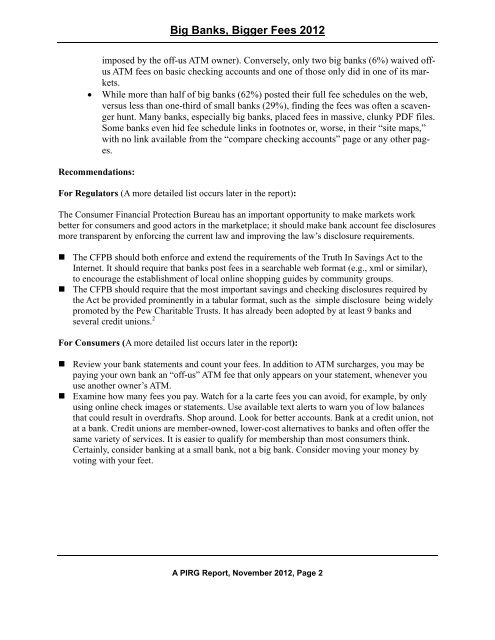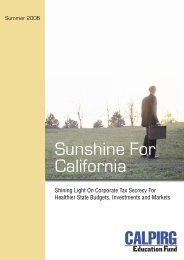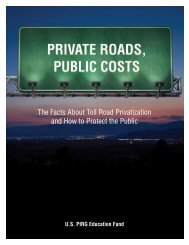Big Banks, Bigger Fees 2012 - US PIRG
Big Banks, Bigger Fees 2012 - US PIRG
Big Banks, Bigger Fees 2012 - US PIRG
Create successful ePaper yourself
Turn your PDF publications into a flip-book with our unique Google optimized e-Paper software.
<strong>Big</strong> <strong>Banks</strong>, <strong>Big</strong>ger <strong>Fees</strong> <strong>2012</strong><br />
<br />
imposed by the off-us ATM owner). Conversely, only two big banks (6%) waived offus<br />
ATM fees on basic checking accounts and one of those only did in one of its markets.<br />
While more than half of big banks (62%) posted their full fee schedules on the web,<br />
versus less than one-third of small banks (29%), finding the fees was often a scavenger<br />
hunt. Many banks, especially big banks, placed fees in massive, clunky PDF files.<br />
Some banks even hid fee schedule links in footnotes or, worse, in their “site maps,”<br />
with no link available from the “compare checking accounts” page or any other pages.<br />
Recommendations:<br />
For Regulators (A more detailed list occurs later in the report):<br />
The Consumer Financial Protection Bureau has an important opportunity to make markets work<br />
better for consumers and good actors in the marketplace; it should make bank account fee disclosures<br />
more transparent by enforcing the current law and improving the law’s disclosure requirements.<br />
• The CFPB should both enforce and extend the requirements of the Truth In Savings Act to the<br />
Internet. It should require that banks post fees in a searchable web format (e.g., xml or similar),<br />
to encourage the establishment of local online shopping guides by community groups.<br />
• The CFPB should require that the most important savings and checking disclosures required by<br />
the Act be provided prominently in a tabular format, such as the simple disclosure being widely<br />
promoted by the Pew Charitable Trusts. It has already been adopted by at least 9 banks and<br />
several credit unions. 2<br />
For Consumers (A more detailed list occurs later in the report):<br />
• Review your bank statements and count your fees. In addition to ATM surcharges, you may be<br />
paying your own bank an “off-us” ATM fee that only appears on your statement, whenever you<br />
use another owner’s ATM.<br />
• Examine how many fees you pay. Watch for a la carte fees you can avoid, for example, by only<br />
using online check images or statements. Use available text alerts to warn you of low balances<br />
that could result in overdrafts. Shop around. Look for better accounts. Bank at a credit union, not<br />
at a bank. Credit unions are member-owned, lower-cost alternatives to banks and often offer the<br />
same variety of services. It is easier to qualify for membership than most consumers think.<br />
Certainly, consider banking at a small bank, not a big bank. Consider moving your money by<br />
voting with your feet.<br />
A <strong>PIRG</strong> Report, November <strong>2012</strong>, Page 2




